B4.1 The blood AQA GCSE Biology B4 The blood: Kerboodle Answer Page No. 98
- How your immune system works
- How vaccination protects you against disease
- Every Organism has its own immune system which recognises the foreign particles. On the surface of cells unique proteins are present which are known as antigens. Antigens present on microorganisms are different from the antigens present in our own body cells. Thus immune system will recognise them as foreign and react on them.
- For reacting with antigen white blood cells of our body will produce antibodies specific to that antigen. This antibody-antigen reaction will destroy or inactivate the particular pathogen.
- There are memory cells (white blood cells) in our body which will remember what antibody will be required for particular antigen containing pathogen. These memory cells will produce specific antibody whenever the pathogen attacks again. By this way immunity against particular pathogen will be achieved.
- First exposure to any pathogen will result in illness because of the absence of specific antibody or previous encounter.
- Vaccination is there to combat for serious diseases such as meningitis. These serious diseases show their effect quickly and result in death before your body can generate antibody against them. Process of vaccination is known as immunisation.
- Vaccines are nothing but dead or inactivated form of a disease causing microorganisms. Immunisation will evoke natural immune responses against invading pathogen.
- Vaccines will create memory to fight the pathogen and prevent us from getting ill because of the invading pathogen. Dead or inactivated part of pathogen introduced in the form of vaccines will stimulate the white blood cells and in this form create memory against that pathogen. In future those memory cells will make the right antibody just as if you had a previous exposure to that pathogen and protect you from the pathogen.
- Vaccines are used against bacterial diseases such as tetanus and diphtheria and viral disease such as polio, measles and mumps. MMR vaccine is an example of vaccine which is used against measles, mumps and rubella. Millions of lives are saved by using vaccines.
- Small pox is an example of disease which has been completely wiped out by vaccination and polio is another target in this series.
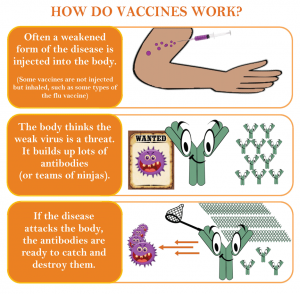
| Figure: Mechanism by which vaccines act in our body and protect us from disease encounter. Source: http://hcrc.missouri.edu/2015/08/05/im-kind-of-a-little-big-deal-public-health-ninjas/ |
- Herd immunity is also known as community immunity. It occurs when the vaccination of a significant portion of a population (or herd or community) provides a measure of protection for individuals who have not developed immunity.
- It arises when a high percentage of the population is protected through vaccination against a virus or bacteria, making it difficult for a disease to spread because there are so few susceptible people left to infect.
- If by chance the number of people taking up the vaccine decreases, the herd immunity will be lost which will result in disease reappearance.
- In 1970s in the UK there was an outbreak of whooping cough due the scare about the safety of vaccine. Vaccination rate was decreased from over 80% to around 30%. As a result of this thousands of children got whooping cough again and a large number died. Later on people realised that the vaccine was safe and herd immunity was achieved again by vaccination of enough children.
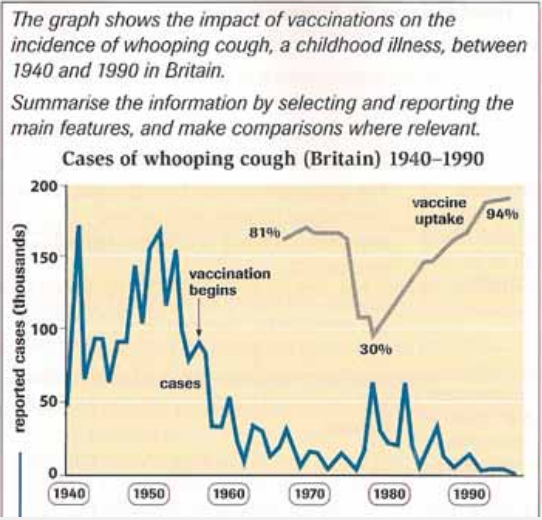
| Source: https://www.testbig.com/ielts-writing-task-i-essays/graph-shows-impact-vaccination-incidence-whooping-cough-childhood-0 |
- In order to achieve herd immunity against tetanus in mothers and new born babied, polio and measles; global vaccination programmes are run by world health organisation. WHO want 95% of children to have vaccination of measles, so that they can achieve global herd immunity against measles. According to current global figures 85% of children get frist dose of vaccine and only 56% get second dose.
- In order to achieve herd immunity at global scale money and strong determination is required. Advantages of herd immunity to individuals and global economics are huge.
- Describe what an antibody is.
- Give an example of one bacterial and one viral disease that you can be immunised against.
- Explain, using diagrams if they help you:
- how the immune system of your body works,
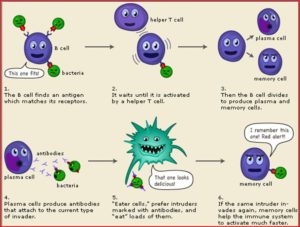 Source: https://www.slideshare.net/PeterCorless/how-the-immune-system-protects-your-body
Source: https://www.slideshare.net/PeterCorless/how-the-immune-system-protects-your-body
- how vaccines use your natural immune system to protect you against diseases.
| Figure: Mechanism by which vaccines act in our body and protect us from disease encounter. Source: http://hcrc.missouri.edu/2015/08/05/im-kind-of-a-little-big-deal-public-health-ninjas/ |
- Explain why vaccines can be used against both bacterial and viral diseases.
B4.2 Antibiotics and painkillers AQA GCSE Biology B4 Antibiotics and painkillers: Kerboodle Answer Page No. 100
Learning objective
After this topic, you should know:
- What medicines are and how some of them work
- That painkillers and other medicines treat disease symptoms but not kill pathogens
- The ways in which antibiotics can and cannot be used.
- Medicines are nothing but contain useful drugs that we take when we have infectious disease. Medicine as vaccines will not kill or affect the pathogen instead it will release the symptoms of the disease and thus make us feel better.
Treating the symptoms
- Aspirin and paracetamol are commonly taken painkillers. Cold problems like fever, sore throat and headache can be treated by taking such medicines. Viruses are not get affected by these drugs.
- Medicines will not kill or destroy the pathogens but it will decrease the intensity of symptoms. Immune system will fight against them by own and activation of immune system will take some days. Thus it will take some days in getting well.
Antibiotics- drugs to cure bacterial diseases
- There are two different types of drugs: drugs that makes you feel better and drugs that actually cure you. Antiseptics are there which can act as disinfectant to kill bacteria outside the body but cannot be used inside of the body. They can be harmful and poisonous if taken internally.
- Antibiotics are there to treat communicable diseases. It can work inside of your body and kill the bacterial pathogens. Antibiotics can only be used in case of bacterial infection.
- Antibiotics have been playing an important role against communicable diseases and have decreased the troll of deaths because of these diseases.
- From 1940s antibiotics are widely available. They were also known as wonder drugs. A successful example of use of antibiotic was the number of deaths because of the infections in the first days after giving birth was dropped.
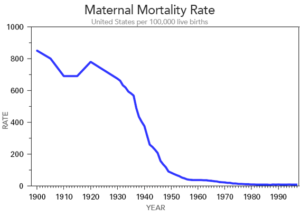
Figure: In 1940s, a successful example of use of antibiotic was seen. The number of deaths because of the infections in the first days after giving birth was dropped significantly. Source: http://www.slate.com/articles/health_and_science/science_of_longevity/2013/09/death_in_childbirth_doctors_increased_maternal_mortality_in_the_20th_century.html |
How antibiotics work
- Antibiotics will kill the disease causing bacteria. Example of antibiotic is penicillin. They will act specifically on bacterial cells not your body cells. They will damage the bacterial cells thus hinder the growth of bacteria.
- Bacterial diseases that have been creating major impact on lives are now can treated using antibiotics. Thus, antibiotics are creating an enormous effect on our society.
- Antibiotics are there in the form of a pill, syrup and injections. Antibiotic injections are used when the patient is not able to take pill or syrup or if the patient is very ill. Injections are directly injected to bloodstream. Thus injections will result in quick relief from the disease symptoms.
- Antibiotics can be broad range or narrow range. Broad range antibiotics can kill wide range bacteria whereas narrow range antibiotics are more specific and can be used for particular bacteria.
- Selection of antibiotic is very important.
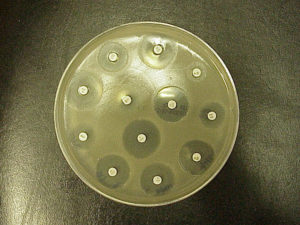
Figure: Several different antibiotics are tested on agar plate. Source: https://en.wikipedia.org/wiki/Antibiotic_sensitivity |
Usages of antibiotics have some drawbacks also. They are not the complete solution to the problems created by infectious diseases.
- Viral diseases cannot be cured by using antibiotics. Viruses multiply inside of host cell. Thus it is challenging to develop drugs which will kill only viruses but will not create any negative effect on cells.
- As we all know that evolution is an ongoing process. Bacteria also evolve and become simultaneously and as a result they become resistant antibiotics. Thus the antibiotic which was developed earlier for a particular bacteria will no longer show effect on those bacteria.
- Antibiotic resistant strain of bacteria is a matter of concern for scientist. Thus new antibiotics should be developed time to time to overcome this challenge which is also a major problem.
Questions and answers:
Q1. Describe the main difference between drugs such as paracetamol and drugs such as penicillin.
And 1 Paracetamol is commonly taken as painkiller. Cold problems like fever, sore throat and headache can be treated by taking such medicines. Viruses are not get affected by these type of drugs. Medicines will not kill or destroy the pathogens but it will decrease the intensity of symptoms. Immune system will fight against them by own and activation of immune system will take some days. Thus it will take some days in getting well.
Penicillin is an antibiotic. Antibiotics will kill the disease causing bacteria. Example of antibiotic is penicillin. They will act specifically on bacterial cells not your body cells. They will damage the bacterial cells thus hinder the growth of bacteria.
Q2. Explain why it is more difficult to develop medicines against viruses than it has been to develop antibiotics.
Ans 2 Viral diseases cannot be cured by using antibiotics. Viruses multiply inside of host cell. Thus it is challenging to develop drugs which will kill only viruses but will not create any negative effect on cells.
Q3. Use figure 2 to answer the following.
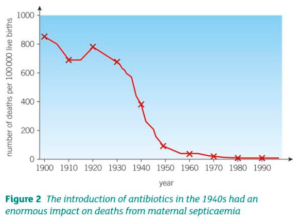
- State how many women died in childbirth or shortly afterwards in 1930, 1940 and 1950 from maternal septicaemia.
And a In 1930= 700, in 1940= 400 and in 1950 around 100 women were died due to maternal septicaemia.
- Calculate the percentage fall or rise in the death rates of mothers around the time of birth in:
i 1930 and 1940
Ans i. There is fall in numbers of women death from 1930 to 1940. The number of deaths was in 1930=700 and in 1940=400. To calculate percentage fall the formula is as follows:
First: work out the difference (decrease) between the two numbers you are comparing.
Decrease = Original Number – New Number
Then: divide the decrease by the original number and multiply the answer by 100.
% Decrease = Decrease ÷ Original Number × 100
Decrease = 700-400= 300
Percentage decrease= 300/ 700*100= 42.8%
Thus percentage fall in death rates of mothers around the time of birth in 1930 and 1940 is 42.8%.
ii 1940 and 1950
Decrease= 400-100= 300
Percentage decrease= 300/400*100= 75%.
Thus percentage fall in death rates of mothers around the time of birth in 1940 and 1950 is 75%.
- Suggest reasons for these observation.
Ans c. The reason for these observations is: from 1940s antibiotics are widely available. They were also known as wonder drugs. A successful example of use of antibiotic was the number of deaths because of the infections in the first days after giving birth was dropped.
- Based on this evidence, explain why the emergence of antibiotic-resistant bacteria is such a cause of concern.
Ans d. As we all know that evolution is an ongoing process. Bacteria also evolve and become simultaneously and as a result they become resistant antibiotics. Thus the antibiotic which was developed earlier for a particular bacteria will no longer show effect on those bacteria. Antibiotic resistant strain of bacteria is a matter of concern for scientist. Thus new antibiotics should be developed time to time to overcome this challenge which is also a major problem.
B6.3 Discovering drugs AQA GCSE Biology B6 Discovering drugs: Kerboodle Answer Page No. 102
Learning objectives
After this topic, you should know:
- Some of the drugs traditionally extracted from plants
- How penicillin was discovered
- How scientists look for new drugs
- From ancient time plants and microorganisms are being used to extract drugs. Mouldy breads were used on septic wounds for treating them.
- Nowadays chemicals extracted from the plants, microorganisms and animals to make effective drugs.
Drugs form plants
- Plants are major contributors in medicinal area of research. Usage of plant drugs are also mentioned in so money holly books.
- From foxgloves Digitalis and Digoxin drugs are extracted. They are known to strengthen the heartbeat since 18th century till now.
- If this drug is taken in large amount it can be poisonous.
- Aspirin which is majorly used as painkiller is extracted from a compound found in the bark of willow trees. It has anti-inflammatory and pain-relieving which was first reported in 400BC.

Figure: Beaver rat chew the willow bark. As a result of which their tail glands has pain-relieving properties. By chewing the tail of beaver relief in pain is observed. Source: http://www.wildernessclassroom.com/wilderness-library/beaver/
|
- Felix Hoffman in 1897 synthesised a similar compound to aspirin known as acetyl salicylic acid. This has shown better effects than willow bark but has some side effects. Wide range of health problems are still treated with aspirin.
Drugs from microorganisms-discovering penicillin
- During early 20th century, scientists were doing intensive research for discovering chemicals that might cure bacterial diseases by killing them. Alexander Fleming was doing his studies on bacterial culture in 1928. During that time healthy and safety procedures were not so up to the mark.
- One day Fleming saw some moulds growing on his culture plates and around that moulds clear ring of jelly was observed. Those rings are formed because of some inhibitory substances was secreted by mould which inhibited the growth of bacteria. Fleming called that substance that inhibits the growth of bacteria as penicillin because it was produced by Penicillium
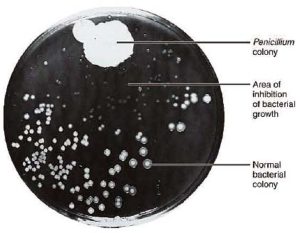
He tried to extract that compound but failed to do so.
- 10 years later of discovery of penicillin, Ernst Chain and Howard Florey were succeeded in extracting penicillin from They tested this extracted drug on a man who was dying because of the blood infection and saved his life until the penicillin ran out. They were not able to save that man’s life but able to proof that penicillin can be used to cure the bacterial infections. Florey and Chain worked with Pfizer situated in USA and made penicillin on large scale which was used during World War II. It is still used today.
Medicines for the future
- It is not an easy task to discover new medicines. It a major challenge to discover such drugs or chemicals that will only kill the bacteria not the human cells. Pharmaceutical industries are using chemical banks and computer models to discover and synthesise more and more drugs. Plants and microorganisms are used as starting material in drug synthesis. Compounds having antibiotic properties are modified in order to make them more powerful molecules. These modified molecules can be synthesised easily and cheaply.
- In Costa Rica, noni fruit is widely used as traditional medicine to treat infections and non-communicable diseases. People have also being used this for food and drink from centuries. There are no side effects of this fruit. Recently antibiotic properties are reported in noni fruit. Research is being carried out to find whether this plant can be a source of antibiotics and other medicines.

Figure: Noni fruit potential source of antibiotics. Source: https://greenblender.com/smoothies/4432/health-benefits-of-noni-fruit |
- Soil microbes collected from different soil samples are being tested for their antibiotic properties. In this way scientist are searching new antibiotics which will work against the antibiotic resistant bacteria.
- 1% of total soil microbes can be cultured in labs. Special units are being generated by scientist who will help them to culture microbes in soil only in a controlled manner.
- In 2015, new antibiotic was discovered from some soil bacteria. This antibiotic has properties to destroy all bacteria including MRSA and other antibiotic resistant pathogens. This antibiotic was tested in mice and there is a question mark if that will work in humans.
Questions and answers:
Q1 Describe how Alexander Fleming discovered penicillin.
Ans 1 During early 20th century, scientists were doing intensive research for discovering chemicals that might cure bacterial diseases by killing them. Alexander Fleming was doing his studies on bacterial culture in 1928. During that time healthy and safety procedures were not so up to the mark. One day Fleming saw some moulds growing on his culture plates and around that moulds clear ring of jelly was observed. Those rings are formed because of some inhibitory substances was secreted by mould which inhibited the growth of bacteria. Fleming called that substance that inhibits the growth of bacteria as penicillin because it was produced by Penicillium mould.
Ans 2 Plant extracts are assumed to be safe but sometime they show poisonous effects. It is difficult to control the concentration and dose of drug in plant extraction. Where poisoning from medicinal plants has been reported, it usually has been due to misidentification of the plants in the form, in which they are sold, or incorrectly preparation and administration by inadequately trained personnel. Herbal drugs are considered less potent than prescribed medicines. While many drugs have originated from biologically active plant chemicals, and many plants’ medicinal uses can be attributed to various active chemicals found in them, there is a distinct difference between using a medicinal plant and a chemical drug. Drugs usually consist of a single chemical, whereas medicinal plants can contain 400 or more chemicals. It’s relatively easy to figure out the activity and side effects of a single chemical, but there is just no way scientists can map all the complex interactions and synergies that might be taking place between all the various chemicals found in a plant, or a traditionally prepared crude plant extract, containing all these chemicals. Thus it is recommended to use synthetic drugs rather than plant extracts directly.
Ans 3 It is not an easy task to discover new medicines. It a major challenge to discover such drugs or chemicals that will only kill the bacteria not the human cells. Pharmaceutical industries are using chemical banks and computer models to discover and synthesise more and more drugs. Plants and microorganisms are used as starting material in drug synthesis. Compounds having antibiotic properties are modified in order to make them more powerful molecules. These modified molecules can be synthesised easily and cheaply. In Costa Rica, noni fruit is widely used as traditional medicine to treat infections and non-communicable diseases. People have also being used this for food and drink from centuries. There are no side effects of this fruit. Recently antibiotic properties are reported in noni fruit. Research is being carried out to find whether this plant can be a source of antibiotics and other medicines.
B6.4 Developing drugs AQA GCSE Biology B6 Developing drugs : Kerboodle Answer Page No. 104
Learning objective
After this topic, you should know:
- The stages involved in testing and trialling new drugs
- Why testing new drugs is so important
- Scientist and doctors are developing new medicines all the time to find more and more ways to cure different diseases. Developed medicines are tested in laboratories. Before use of any medicine it is tested and trialled at different stages. Trials and testing are necessary to be sure that use of the medicine is safe and secure and it works well to treat the disease.
- The properties of a good medicine are as following:
- It should be effective. It must make you feel better.
- It should be safe. It should be non toxic and should have least or no side effects.
- It should be stable. The medicine must be remaining of same composition under normal conditions and you must be able to store it for some time.
- It should be successfully taken into and removed from your body. It should be target specific and must be cleared from the body system.
Developing and testing a new drug
- It takes a lot of time and money to release some medicine for use. Before release of some medicine extensive trials are done.
- Scientist make huge amount of possible drugs for a disease. These drugs are further tested in laboratory to find out their toxicity and efficacy. They are tested on cells, tissues and even on whole organs.
- Only few of the chemicals will pass the previous tests, remaining will be further tested in laboratory on animals. This testing will provide information about the doses and side effects of that drug. By doing this type of testing behaviour of the drug can be predicted.
- The above said testing steps are preclinical testing. This type of testing is limited to laboratory trials on animals only.
- The later step of testing is clinical testing. For this testing healthy volunteers and patients are used. Very low amount of drug dose is given to healthy volunteer to find out the side effects of the drug. If the drug has no side effects then it is given to a small number of patients to see whether they feel improvement or not after taking the drug. If it proves to be safe and effective then bigger trials take place. By doing bigger trials scientist optimize the dose of the drug.
- If the medicine passes all the legal tests and trials, it will be licensed and doctor can prescribe that medicine.
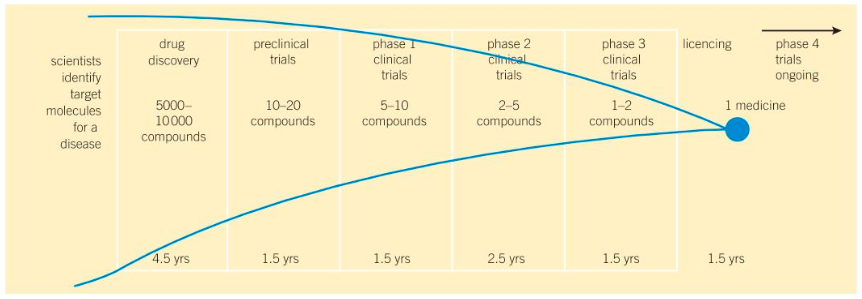
Figure: Figure showing the testing and trial stages for a drug before its release. An enormous number of chemicals start the selection process but few actually become a new useful drug.
Double blind trails
- Double blind trial is used by scientist to see how effective the new medicine.
- A group of patient take part in this trail. Some patients are given placebo that does not contain drug and some are given the new drug. Patients are assigned to different groups. Neither the doctor nor the patient know whether they have been given placebo or the drug until the trial is completed.
- Patient health is monitored carefully on regular basis.
- In case of placebo previously used and approved drugs are included. This means the patient is not deprived of the treatment whilst taking part in the drug trials.
Publishing results
- Drug trial and test results are published in a journal. During the process of publishing their findings the research in scrutinised in a process of peer review. By doing so false claims can be find out.
- The final decision is made by national bodies such as National Institute for Health Care Excellence (NICE). NICE will look at the published results of drug trials and then decide the good value for money and should prescribed by NHS.
Question answers:
Ans 1 Efficacy: Efficacy is the maximum effect produced by drug regardless of the dose.
Toxicity: Toxicity refers to how poisonous or harmful a substance can be. In the context of pharmacology, drug toxicity occurs when a person has accumulated too much of a drug in his bloodstream, leading to adverse effects on the body.
Dosage: A dosage is the amount of a medicine or drug that someone takes or should take.
Ans 2 a. To release a new drug it takes a lot of money and time. The following stages are there in drug testing:
- It takes a lot of time and money to release some medicine for use. Before release of some medicine extensive trials are done.
- Scientist make huge amount of possible drugs for a disease. These drugs are further tested in laboratory to find out their toxicity and efficacy. They are tested on cells, tissues and even on whole organs.
- Only few of the chemicals will pass the previous tests, remaining will be further tested in laboratory on animals. This testing will provide information about the doses and side effects of that drug. By doing this type of testing behaviour of the drug can be predicted.
- The above said testing steps are preclinical testing. This type of testig is limited to laboratory trials on animals only.
- The later step of testing is clinical testing. For this testing healthy volunteers and patients are used. Very low amount of drug dose is given to healthy volunteer to find out the side effects of the drug. If the drug has no side effects then it is given to a small number of patients to see whether they feel improvement or not after taking the drug. If it proves to be safe and effective then bigger trials take place. By doing bigger trials scientist optimize the dose of the drug.
- If the medicine passes all the legal tests and trials, it will be licensed and doctor can prescribe that medicine.
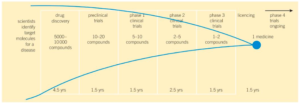
Figure: Figure showing the testing and trial stages for a drug before its release. An enormous number of chemicals start the selection process but few actually become a new useful drug.
- Explain why an active drug is often used as the placebo in a clinical trial instead of a sugar pill that has no side effect.
Ans b. If there is already a drug which works reasonably well against a disease, it would be unethical not to give that to a patient. It also allows us to compare how good the new drug is compared to existing drugs. It can only be done if there is already an active drug available.
Ans 3 Thalidomide wasn’t developed as a drug for morning sickness, but it turned out to have a beneficial effect and it was assumed that it would be safe. Extensive testing on pregnant animals was not carried out. Thalidomide uses resulted in limb deformities in developing foetuses. There was a lower standard of testing in those days. Thus it is necessary to use new drugs after tests and trials.
B6.5 Making monoclonal antibodies AQA GCSE Biology B6 Making monoclonal antibodies: Kerboodle Answer Page No. 106
Learning objective
After this topic, you should know:
- How monoclonal antibodies are produced
- How monoclonal antibodies are used.
- Hybridoma technology is newly discovered technology. In this hybridomas are produced. Hybridomas are nothing but result of fusion of two different cell types. Such as cells of mice and human and cells of cancer and normal cell are combined together.
Making monoclonal antibodies
- Like vaccination monoclonal antibodies are also depend on the immune system. Monoclonal antibody is a type of antibody only. They are proteins that are produced to target a particular cell or chemical. Some of the White blood cells can make antibodies but cannot divide. Tumour cells have tendency to divide rapidly but do not produce antibodies.
- Researchers combine mice lymphocytes with a tumour cell. The combined cell is called hybridoma cell. Thus the produced hybridoma cell is now able to divide like a tumour cell and produce antibodies like a lymphocyte. Antibodies produced from these type of cells collected and purified. This antibody is known as monoclonal antibody. Monoclonal antibodies are nothing but the antibodies produced by a single clone of cells.
- Scientists have also combined a mice cell with a human cell in order to produce human antibodies which are less likely to be rejected by human cells.
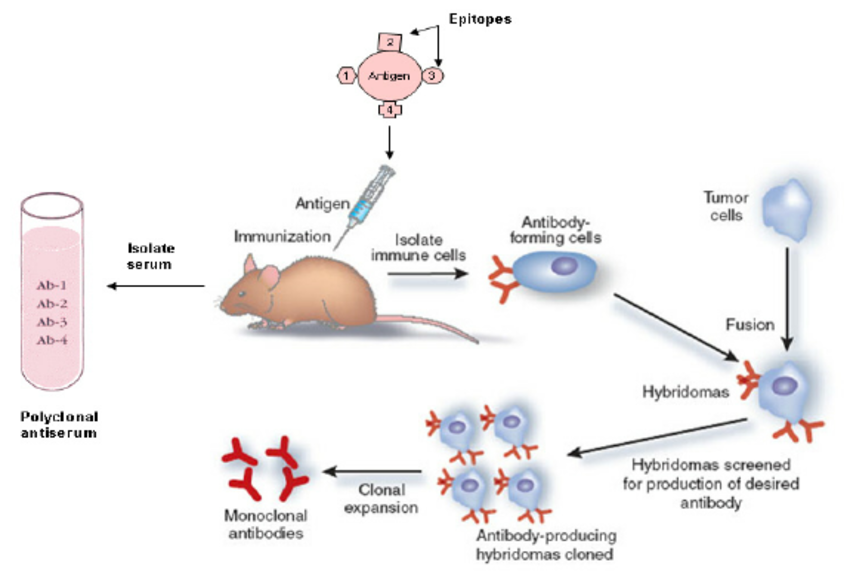
Figure: Production of hybridomas and monoclonal antibodies. Source: https://www.researchgate.net/publication/221929573_Immunoaffinity_Chromatography_A_Review/figures?lo=1 |
Using monoclonal antibodies
- Antigens are nothing but protein molecules present on the cell surface. Some time free protein molecules can also act as antigens.
- Monoclonal antibodies are specific to one binding site of an antigen and are produced form a single clone of cells. The antigens are specific to cell type. Monoclonal antibodies can only target and bind to one specific antigen thus can be used in several ways.
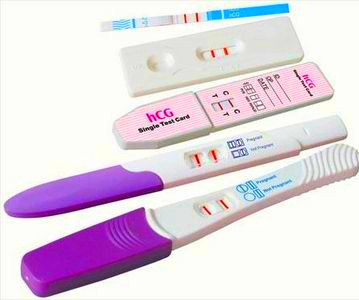
Figure: Pregnancy test kit. Source: http://www.elisa-antibody.com/ELISA-applications/home-pregnancy-test |
- Pregnancy test: One commonly used example which is based on monoclonal antibody use is pregnancy test. In this antibodies are specific for the hormone human chorionic gonadotropin (HCG). HCG is the hormone produced in the early stages of pregnancy. This hormone in tiny amount is passed with urine thus can be detected with this test kit. Change in colour is observed if the urine sample contains the HCG hormone.
- Disease diagnosis: Monoclonal antibodies are used to diagnose the diseases. They bind to specific antigens present on the pathogens, or on blood clots or on cancer cells. Monoclonal antibodies are labelled with markers thus their location can be detected. In this way doctors can detect the problem before they create serious conditions for pateint’s health. During the blood test for prostate cancer antibodies are used which are specific to antigen expressing on prostate cells. Monoclonal antibodies are not only used in case of human but also in plants and animals for disease detection.
- Measuring and monitoring: Monoclonal antibodies are also used to monitor and measure the levels of hormones in the blood samples in hospitals and laboratories. Screening of blood for HIV infection, dope test or test done to detect the drug which have been illegally used by athletes and also for detection some infections such as syphilis are done by using monoclonal antibodies.
- Research: In research monoclonal antibodies are used to locate and identify specific molecules in a cell or tissue. Monoclonal antibodies are linked to fluorescent dye are generated and when it binds to desired molecules it will show build-up of fluorescence.
- Treating diseases: Monoclonal antibodies are also used to treat disease which will be further explained in B6.6.
- ELISA: Enzyme Linked Immunosorbent Assay (ELISA) is used to detect diseases. In this monoclonal antibodies are used to detect antigens and pathogens in the samples. This technique is majorly used in research.
Question answers:
Ans 1 a. Clone is a identical copy of cell.
- Define antibody
Ans 1 b. Antibodies are proteins synthesised by the white blood cells in response to detected foreing particles or pathogens.
- Define a monoclonal antibody.
Ans c. Researchers combine mice lymphocytes with a tumour cell. The combined cell is called hybridoma cell. Thus the produced hybridoma cell is now able to divide like a tumour cell and produce antibodies like a lymphocyte. Antibodies produced from these type of cells collected and purified. This antibody is known as monoclonal antibody. Monoclonal antibodies are nothing but the antibodies produced by a single clone of cells.
- a. Describe a hybridoma cell.
Ans 2 a. Like vaccination monoclonal antibodies are also depend on the immune system. Monoclonal antibody is a type of antibody only. They are proteins that are produced to target a particular cell or chemical. Some of the White blood cells can make antibodies but cannot divide. Tumour cells have tendency to divide rapidly but do not produce antibodies. Researchers combine mice lymphocytes with a tumour cell. The combined cell is called hybridoma cell. Thus the produced hybridoma cell is now able to divide like a tumour cell and produce antibodies like a lymphocyte. Antibodies produced from these type of cells collected and purified. This antibody is known as monoclonal antibody. Monoclonal antibodies are nothing but the antibodies produced by a single clone of cells. Scientists have also combined a mice cell with a human cell in order to produce human antibodies which are less likely to be rejected by human cells.

Figure: Production of hybridomas and monoclonal antibodies. Source: https://www.researchgate.net/publication/221929573_Immunoaffinity_Chromatography_A_Review/figures?lo=1 |
- Explain the importance of hybridoma cells in the production of monoclonal antibodies.
Ans 2 b. Like vaccination monoclonal antibodies are also depend on the immune system. Monoclonal antibody is a type of antibody only. They are proteins that are produced to target a particular cell or chemical. Some of the White blood cells can make antibodies but cannot divide. Tumour cells have tendency to divide rapidly but do not produce antibodies. Researchers combine mice lymphocytes with a tumour cell. The combined cell is called hybridoma cell. Thus the produced hybridoma cell is now able to divide like a tumour cell and produce antibodies like a lymphocyte. Antibodies produced from these type of cells collected and purified. This antibody is known as monoclonal antibody. Monoclonal antibodies are nothing but the antibodies produced by a single clone of cells. Scientists have also combined a mice cell with a human cell in order to produce human antibodies which are less likely to be rejected by human cells.
Q3 Explain how monoclonal antibodies have revolutionised the diagnosis pf pregnancy.
Ans 3. Mmonoclonal antibodies have revolutionised the diagnosis of pregnancy. One commonly used example which is based on monoclonal antibody use is pregnancy test. In this antibodies are specific for the hormone human chorionic gonadotropin (HCG). HCG is the hormone produced in the early stages of pregnancy. This hormone in tiny amount is passed with urine thus can be detected with this test kit. Change in colour is observed if the urine sample contains the HCG hormone.
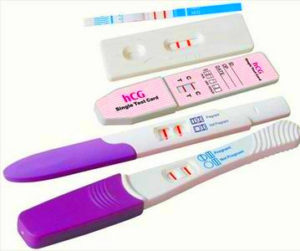
Figure: Pregnancy test kit.
Source: http://www.elisa-antibody.com/ELISA-applications/home-pregnancy-test
B6.6 Uses of monoclonal antibodies AQA GCSE Biology B6 Uses of monoclonal antibodies: Kerboodle Answer Page No. 108
Learning objectives
After this topic, you should know:
- Some uses of monoclonal antibodies
- Advantages and disadvantages of using monoclonal antibodies.
- ‘Magic bullet’ was first imagined by Nobel Prize winner Paul Ehrlich in 20th It was a way to precisely target a drug at a pathogen or disease. After the discovery of monoclonal antibodies scientist thought they had found the magic bullet described by Paul Erlich.
Treatment of disease
- Sceintist are looking to use monoclonal antibodies to treat very specific diseases. There are different types of cancer and treatment for some are still not known in science. So scientists are working in this direction to develop specific monoclonal antibodies against the specific type of cancer. The success is enormous.
- There are three different ways of using monoclonal antibodies to treat cancers. Each way has its importance and produced some cancer treatments which scientists are using and many more are ready for clinical trials. They are as following:
- Monoclonal antibodies are directly used to trigger the immune system to recognise, attack and destroy cancer cells.
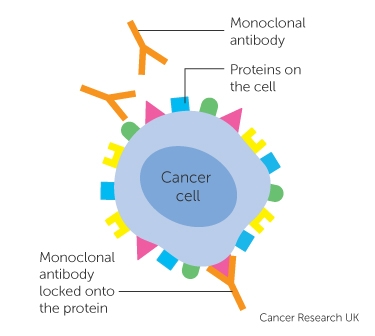
Figure: Monoclonal antibody directly attack on cancer cells and destroy them. Source: http://www.cancerresearchuk.org/sites/default/files/styles/cruk_wide_resp_breakpoint_one/public/diagram-showing-a-monoclonal-antibody-attached-to-a-cancer-cell_1.jpg?itok=R7imAS1Y |
- Monoclonal antibodies are used to block the cell surface receptors present on the cancer cells, thus stop the cells from growing and division.
- Monoclonal antibodies are also used in radiation therapy. These are used to carry toxic drugs or radioactive substances or chemicals which will stop the cancer cells from growth and division. This is very specific and will only target cancer cells not the other cells.
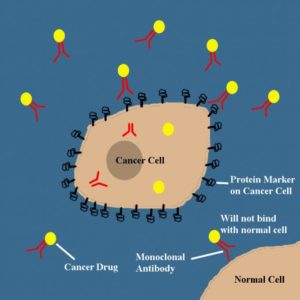
Figure: Monoclonal antibodies are linked with raditoactive substances or toxic chemical that will detect the cancer cell and destroy them. Source: https://usercontent2.hubstatic.com/6712809_f520.jpg |
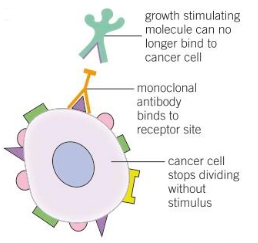
Figure: Growth receptors of cancer cells are blocked by monoclonal antibodies thus the cancer cell cannot divide and grow after that. |
Advantages and disadvantages of monoclonal antibodies
- Advantages of monoclonal antibodies are as follows:
- Binding of monoclonal antibodies are very specific. They will only bind to diseased or damaged cells but not to the healthy cells. Whereas conventional treatment will damage the healthy cells also. Radiotherapy of cancer cells will also affect the healthy non cancerous cells also.
- Monoclonal antibodies are being specific can be used in treatment of wide range of conditions. Monoclonal antibody development is very expensive but they can be cheaper than the conventional method development because development of monoclonal antibody is based on tested technologies.
- Monoclonal antibody treatment is not that much successful as expectations of scientists. Because initially it created side effects due to the use of mouse cells. Mouse antibodies are produced in human. This resulted in back research. But nowadays hybrids of mouse and human cells are used and the uses of fraction of antibodies to carry drugs to target cells are resulted in reduced side effects. Treatments are there for side effects caused by monoclonal antibodies.
- It is not an easy task to produce target specific monoclonal antibodies as expected. Development of more and more skills is required for creating these magic bullets.
Question answers:
Ans 1 Sceintist are looking to use monoclonal antibodies to treat very specific diseases. There are different types of cancer and treatment for some are still not known in science. So scientists are working in this direction to develop specific monoclonal antibodies against the specific type of cancer. The success is enormous.
- There are three different ways of using monoclonal antibodies to treat cancers. Each way has its importance and produced some cancer treatments which scientists are using and many more are ready for clinical trials. They are as following:
- Monoclonal antibodies are directly used to trigger the immune system to recognise, attack and destroy cancer cells.
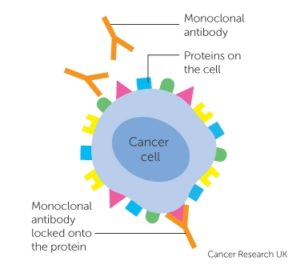
Figure: Monoclonal antibody directly attack on cancer cells and destroy them. Source: http://www.cancerresearchuk.org/sites/default/files/styles/cruk_wide_resp_breakpoint_one/public/diagram-showing-a-monoclonal-antibody-attached-to-a-cancer-cell_1.jpg?itok=R7imAS1Y |
- Monoclonal antibodies are used to block the cell surface receptors present on the cancer cells, thus stop the cells from growing and division.
- Monoclonal antibodies are also used in radiation therapy. These are used to carry toxic drugs or radioactive substances or chemicals which will stop the cancer cells from growth and division. This is very specific and will only target cancer cells not the other cells.

Figure: Monoclonal antibodies are linked with raditoactive substances or toxic chemical that will detect the cancer cell and destroy them. Source: https://usercontent2.hubstatic.com/6712809_f520.jpg |

Figure: Growth receptors of cancer cells are blocked by monoclonal antibodies thus the cancer cell cannot divide and grow after that. |
Ans 2
Advantages and disadvantages of monoclonal antibodies
- Advantages of monoclonal antibodies are as follows:
- Binding of monoclonal antibodies are very specific. They will only bind to diseased or damaged cells but not to the healthy cells. Whereas conventional treatment will damage the healthy cells also. Radiotherapy of cancer cells will also affect the healthy non cancerous cells also.
- Monoclonal antibodies are being specific can be used in treatment of wide range of conditions. Monoclonal antibody development is very expensive but they can be cheaper than the conventional method development because development of monoclonal antibody is based on tested technologies.
- Monoclonal antibody treatment is not that much successful as expectations of scientists. Because initially it created side effects due to the use of mouse cells. Mouse antibodies are produced in human. This resulted in back research. But nowadays hybrids of mouse and human cells are used and the uses of fraction of antibodies to carry drugs to target cells are resulted in reduced side effects. Treatments are there for side effects caused by monoclonal antibodies.
- It is not an easy task to produce target specific monoclonal antibodies as expected. Development of more and more skills is required for creating these magic bullets.
B6 Uses Of monoclonal antibodies : Kerboodle Answer Summary questions:Page No :110
Q1 Vaccination uses your body’s natural defence system to protect you against disease.
- Describe how vaccination works.
Ans a Vaccination is there to combat for serious diseases such as meningitis. These serious diseases show their effect quickly and result in death before your body can generate antibody against them. Process of vaccination is known as immunisation. Vaccines are nothing but dead or inactivated form of a disease causing microorganisms. Immunisation will evoke natural immune responses against invading pathogen. Vaccines will create memory to fight the pathogen and prevent us from getting ill because of the invading pathogen. Dead or inactivated part of pathogen introduced in the form of vaccines will stimulate the white blood cells and in this form create memory against that pathogen. In future those memory cells will make the right antibody just as if you had a previous exposure to that pathogen and protect you from the pathogen.Vaccines are used against bacterial diseases such as tetanus and diphtheria and viral disease such as polio, measles and mumps. MMR vaccine is an example of vaccine which is used against measles, mumps and rubella. Millions of lives are saved by using vaccines.
Figure: Mechanism by which vaccines act in our body and protect us from disease encounter. Source: http://hcrc.missouri.edu/2015/08/05/im-kind-of-a-little-big-deal-public-health-ninjas/ |
- Produce flow chart to summarise the process of developing active immunity after:
- a natural vaccine
ii a vaccination.
Ans b. After taking natural vaccines and vaccination the immune system is triggered and responds in same way. But Natural infection might only induce a small rise in low-affinity antibodies, while vaccination would have to induce protective antibodies. This will result in development of active immunity. The flow chart is as follows:
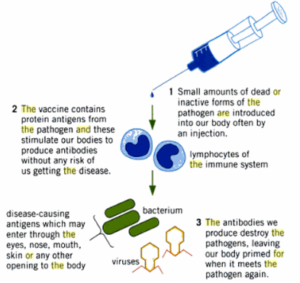
- There are vaccines for diseases such as diphtheria, polio, tetanus, and meningitis, but not for the common cold or tonsillitis. Suggest reason for this.
Ans c. First, what we think of as a cold is actually caused by many different viruses. Even the most common among those, rhinovirus, has more than a hundred different strains. “Curing” a cold and tonsillitis would actually mean eradicating a long list of respiratory viruses that happen to cause similar symptoms. Those symptoms, incidentally, are mostly just your immune system kicking into high gear to fight off an infection, something that can manifest as inflammation in the throat and congestion in the nose. Second, while sniffling and coughing is no fun, a cold is pretty low down on the list of ailments that need curing. It can be a concern for infants, the elderly, or those with pre-existing respiratory conditions, but for the majority of us, a common cold is more annoyance than threat. Thus till now there is no vaccines which can treat the common cold and tonsillitis.
Q2 Meningitis B and meningitis C are infections that can cause inflammation of the membranes around the brain and infection throughout the body (septicaemia). They are particularly serous in young children and teenagers, and can kill rapidly. Use of Figure 1 to help you answer these questions below.
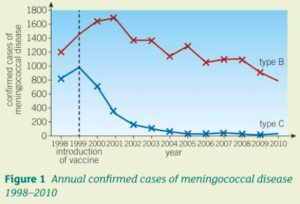
- How many cases of meningitis B and meningitis C were recorded in 1999 ?
Ans a. Cases of type meningitis B in 1999= around 1400 and for meningitis C is around 1000.
- How many cases of meningitis B and meningitis C were recorded in 2005 and 2009 ?
Ans b. For Type C almost 0 patients were recorded whereas for Type B around 1300 patients were recorded.
- Suggest whether the introduction of the meningitis C vaccine in 1999 alone is responsible for the reduction in meningitis cases in the UK between 1998 and 2010. Explain your answer.
Ans c. Meningitis C vaccines are alone responsible for the induction in meningitis cases in UK between 1998 and 2010. This is nothing but an example of herd immunity. Because by that the only best-established single- group vaccine is a conjugate for Meningitis C.
- Suggest one argument for and one argument against the introduction of a new vaccine against meningitis B.
Ans d. There are no vaccines are for meningitis B, the simple reason is that the strategy used for the other meningococci doesn’t work for MenB. Vaccines for meningococcus groups A, C, W, and Y induce an immune response against the polysaccharide capsule around the bacterium. The capsular polysaccharide of MenB however, is structurally similar to certain abundant human glycoproteins like NCAM. It is therefore not a suitable immune target due to the risk of autoimmune damage through molecular mimicry. The barrier to developing a MenB vaccine thus has two faces: the difficulty in developing vaccines in general, and the specific challenge of creating a vaccine against a pathogen that mimics host molecules. The requirements for the development of an effective vaccine for MenB will be examined in three parts: first, an overview of the general characteristics of an effective vaccine; second, a discussion of current meningococcal vaccine strategies and their limitations with regard to MenB; and third, an examination of a promising new strategy for inoculation against MenB.
Q3. a. There are no medicines to cure measles, mumps or rubella. What does this tell you about the pathogens that cause these diseases?
Ans 3 a. These three diseases are caused by viruses thus there are no medicines to cure these diseases. Viruses multiply inside the host cell thus it is difficult to design the medicines which will only destroy the virus infected cells but not the host cells.
- Suggest a medicine that might be used to make people feel more comfortable.
Ans Paracetamol and aspirin are commonly used medicines which are used to make people feel more comfortable.
- Doctors hope to get levels of MMR vaccination against measles, mumps and rubella up to 95% of the population. Why it is important to get vaccination levels so high?
Ans c. These diseases are highly transmissible thus to irridicate these diseases completely from a population high levels of vaccination should be achieved. If the vaccination goals are not achieved then the outbreak of disease will be huge. Thus by seeing the transmissible of the disease the level of vaccination is decided. Higher the transmissibility of a disease higher should be the vaccination level.
Q4 a. Explain why new medicines need to be tested and trialled before doctors can use them to treat their patients.
Ans 4 a. It is required to test and try the new medicines before it comes into market for sale. Trials and tests are required to decide the efficacy, toxicity and dosage level on the new medicine.
- Discuss why the development of a new medicine is so expensive.
Ans b. Developmet of new medicines is so expensive and time consuming. Consider a few basic requirements of the process:
- Discovery: Identify the molecular basis of disease; find a molecular target; find a key (a protein, for example, that binds to molecular target and prevents molecule from performing its normal function); make sure the key doesn’t fit other keyholes that open pathways to unwanted outcomes.
- Preclinical testing: Assess the drug in animals to make sure that it’s effective in an animal model of the human disease and that there are no side effects. Somewhere between one of 10 and one of 100 projects successfully pass these tests and can move from this stage to clinical trial.
- Phase-1 clinical trial: Determine that the drug is safe in humans.
- Phase-2 clinical trial: Determine optimal dose.
- Phase-3 clinical trial: Look for statistically significant benefit. (Can involve 10,000 to 30,000 patients.)
Thus all these phases and steps of drug testing demand not only a huge amount of money but also time also.
- Do you think it would ever be acceptable to use a new medicine before all the trials are completed? Explain the reasoning behind your answer.
Ans My answer is no. Because without trials the dosage level, side effects of that drug are not known. It may cause harm to your body also. If it is not target specific then it can cause damage to other body cells also.
Q5
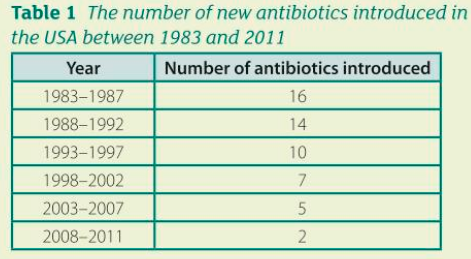
- Use Table 1 to help you explain why there is such pressure to discover new medicines.
Ans a. There is increased demand of new medicines because in the process of evolution the pathogens are also evolving and becoming resistant to drugs.
- Some people argue for the conversation of biodiversity because the living world is a potential source of new medicines. Explain why this argument is not completely accurate.
Ans b. The natural world is a vast resource of chemical and genetic diversity which makes major contributions to medicine. Chemical compounds produced by plants, animals or microbes have been used as medicines for decades – centuries in some cases. Some of the best known examples are the penicillin antibiotics, originally discovered as natural products made by fungi, and the painkiller aspirin, developed by making chemical modifications to a substance in willow bark called salicin. The chemical structures produced in nature are relatively few when compared to all possible structures – an infinite number – but they have been honed through many millions of years of evolution. If lost, these biologically active structures may not be so easily accessible through computational or synthetic means. So we can say that beside nature new drugs can be synthesised in the laboratories also. Thus drug industries are not solely depend on nature. But we cannot ignore the conversation of biodiversity.
- Describe the main steps in the development of a new medicine to the point where it can be used by your local GP or hospital.
Ans 2 c. To release a new drug it takes a lot of money and time. The following stages are there in drug testing:
- It takes a lot of time and money to release some medicine for use. Before release of some medicine extensive trials are done.
- Scientist make huge amount of possible drugs for a disease. These drugs are further tested in laboratory to find out their toxicity and efficacy. They are tested on cells, tissues and even on whole organs.
- Only few of the chemicals will pass the previous tests, remaining will be further tested in laboratory on animals. This testing will provide information about the doses and side effects of that drug. By doing this type of testing behaviour of the drug can be predicted.
- The above said testing steps are preclinical testing. This type of testig is limited to laboratory trials on animals only.
- The later step of testing is clinical testing. For this testing healthy volunteers and patients are used. Very low amount of drug dose is given to healthy volunteer to find out the side effects of the drug. If the drug has no side effects then it is given to a small number of patients to see whether they feel improvement or not after taking the drug. If it proves to be safe and effective then bigger trials take place. By doing bigger trials scientist optimize the dose of the drug.
- If the medicine passes all the legal tests and trials, it will be licensed and doctor can prescribe that medicine.

Figure: Figure showing the testing and trial stages for a drug before its release. An enormous number of chemicals start the selection process but few actually become a new useful drug
Q 6 Evaluate the use of monoclonal antibodies to treat diseases such as cancer.
Ans Sceintist are looking to use monoclonal antibodies to treat very specific diseases. There are different types of cancer and treatment for some are still not known in science. So scientists are working in this direction to develop specific monoclonal antibodies against the specific type of cancer. The success is enormous.
- There are three different ways of using monoclonal antibodies to treat cancers. Each way has its importance and produced some cancer treatments which scientists are using and many more are ready for clinical trials. They are as following:
- Monoclonal antibodies are directly used to trigger the immune system to recognise, attack and destroy cancer cells.

Figure: Monoclonal antibody directly attack on cancer cells and destroy them. Source: http://www.cancerresearchuk.org/sites/default/files/styles/cruk_wide_resp_breakpoint_one/public/diagram-showing-a-monoclonal-antibody-attached-to-a-cancer-cell_1.jpg?itok=R7imAS1Y |
- Monoclonal antibodies are used to block the cell surface receptors present on the cancer cells, thus stop the cells from growing and division.
- Monoclonal antibodies are also used in radiation therapy. These are used to carry toxic drugs or radioactive substances or chemicals which will stop the cancer cells from growth and division. This is very specific and will only target cancer cells not the other cells.

Figure: Monoclonal antibodies are linked with raditoactive substances or toxic chemical that will detect the cancer cell and destroy them. Source: https://usercontent2.hubstatic.com/6712809_f520.jpg |

Figure: Growth receptors of cancer cells are blocked by monoclonal antibodies thus the cancer cell cannot divide and grow after that. |
\
B6 Uses of monoclonal antibodies : Practice questions : Kerboodle Answer Page No : 111
Q1 A scientist investigated how effective five different antibiotics were at killing two types of bacteria, E.coli and S. aureus.
- The scientist grew the bacteria on agar in two different Petri dishes.
- He placed paper discs soaked in the 5 different antibiotic solutions, A, B, C, D and E onto the agar.
- He used the same concentration of each antibiotic and the same sized paper discs.
- The Petri dishes were incubated at 25°C for three days.
A clear area around the paper disc means that the antibiotic has killed the bacteria there. The results are shown in Figure:
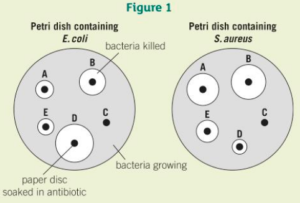
01.1 Give one variable the scientist controlled. Use the results shown in the diagram to help you to answer the following questions.
Ans Scientist controlled the growth temperature and maintained it at 25°C.
01.2 Which antibiotic, A, B, C, D, or E was the most effective at killing E.coli?
Ans: Antibiotic D is more effective in killing the E.coli.
01.3 Which antibiotic, A, B, C, D, or E did not kill either E.coli or S. aureus?
Ans. Antibiotic C did not killed either E.coli or S. aureus.
01.4 Which antibiotic, A, B, C, D, or E would be the best to use to kill both E.coli and S.aureus?
Ans. Antibiotic B would be best to use to kill both E.coli and S.aureus.
01.5 MRSA is a strain of S.aureus. MRSA cannot be killed by most antibiotics.
| Immune powerful resistant |
Use the correct word from the box to complete the sentence.
Bacteria that cannot be killed by antibiotics are………….
Ans Resistant
Q2 New drugs have to be tested before they can be sold. Figure 2 shows how much time the different stages of testing took for a new drug.
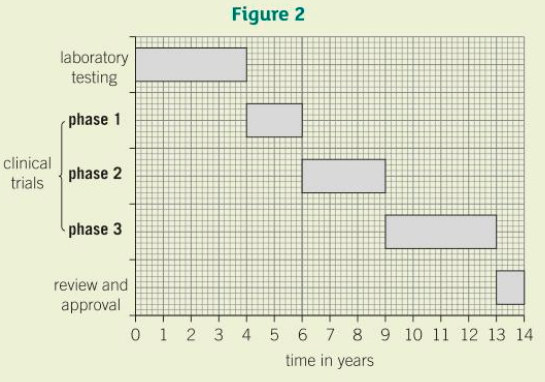
02.1 How much more time did the clinical trials take than the laboratory testing?
Ans. Laboratory testing takes total 4 years whereas three different phases’ clinical trials take total 9 years. Thus clinical trial took 5 more years than laboratory testing.
02.2 Apart from the time taken, what other difference is there between laboratory testing and clinical trials?
Ans It takes a lot of time and money to release some medicine for use. Before release of some medicine extensive trials are done.
Scientist make huge amount of possible drugs for a disease. These drugs are further tested in laboratory to find out their toxicity and efficacy. They are tested on cells, tissues and even on whole organs.
Only few of the chemicals will pass the previous tests, remaining will be further tested in laboratory on animals. This testing will provide information about the doses and side effects of that drug. By doing this type of testing behaviour of the drug can be predicted.
The above said testing steps are preclinical testing. This type of testing is limited to laboratory trials on animals only.
The later step of testing is clinical testing. For this testing healthy volunteers and patients are used. Very low amount of drug dose is given to healthy volunteer to find out the side effects of the drug. If the drug has no side effects then it is given to a small number of patients to see whether they feel improvement or not after taking the drug. If it proves to be safe and effective then bigger trials take place. By doing bigger trials scientist optimize the dose of the drug.
02.3 During Phase 1 clinical trials, the drug is tested on healthy volunteers using low doses.
Suggest why only healthy volunteers and only low doses are used at this stage of drug testing.
Ans For phase 1 clinical trials healthy volunteers and low doses of drug are used because to observe the effect of that drug. If the volunteer used for trials are not healthy then it will matter of concern that whether the effect which volunteer is showing is because of the drug or may be other reason. Low doses are used to avoid dosage effect.
02.4 In phase 2 and phase 3 clinical trials, a double blind trial is usually done. Explain what a double blind trial is and why a double blind trial is good practice.
Ans Double blind trial is used by scientist to see how effective the new medicine. A group of patient take part in this trail. Some patients are given placebo that does not contain drug and some are given the new drug. Patients are assigned to different groups. Neither the doctor nor the patient know whether they have been given placebo or the drug until the trial is completed. Patient health is monitored carefully on regular basis. In case of placebo previously used and approved drugs are included. This means the patient is not deprived of the treatment whilst taking part in the drug trials.
Q3 Monoclonal antibodies are antibodies that target particular cells or chemicals in the body. They are used in diagnostic tests and in the treatment of some disease.
Figure shows how monoclonal antibodies are produces.
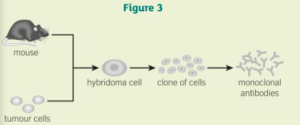
Use this figure and your own knowledge to describe how monoclonal antibodies are produced.
Ans 3. Researchers combine mice lymphocytes with a tumour cell. The combined cell is called hybridoma cell. Thus the produced hybridoma cell is now able to divide like a tumour cell and produce antibodies like a lymphocyte. Antibodies produced from these type of cells collected and purified. This antibody is known as monoclonal antibody. Monoclonal antibodies are nothing but the antibodies produced by a single clone of cells.
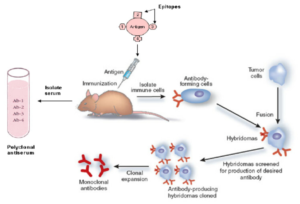
Figure: Production of hybridomas and monoclonal antibodies. Source: https://www.researchgate.net/publication/221929573_Immunoaffinity_Chromatography_A_Review/figures?lo=1 |
Banner 2
Disclaimer: I have tried by level best to provide the answers and video explanations to the best of my knowledge. All the answers and notes are written by me and if there is any similarity in the content then it is purely coincidental. But this is not an alternative to the textbook. You should cover the specification or the textbook thoroughly. This is the quick revision to help you cover the gist of everything. In case you spot any errors then do let us know and we will rectify it.
References:
BBC Bitesize
AQA GCSE Science Kerboodle textbook
Wikipedia
Wikimedia Commons
Join Our Free Facebook Group : Get A* in GCSE and A LEVEL Science and Maths by Mahima Laroyia: https://www.facebook.com/groups/expertguidance.co.uk/
For Free Tips, advice and Maths and Science Help
